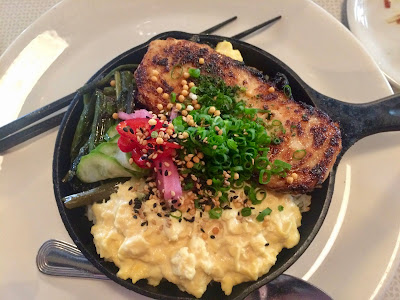 |
| Chef Wong has a great idea on tipping |
The Trump Administration plunged into the problem last year with a proposal that's not a bad idea: that restaurants could redistribute tips among all workers. This is exactly what many conscientious chefs have been trying to do for several years, as this 2016 New York Times story points out. But labor organizations complain that the way the proposed new law is written might allow restaurant owners to simply pocket all the tips.
Tip pooling sounds like a good idea if you think the person who cooked your food should make as much money as the person who brought it to you. But it is hard to enforce legally. And as high-end restaurants have discovered, it's hard to keep servers if they're not getting all the tips because they can get jobs elsewhere where tips are not pooled, whereas the working stiffs in the kitchen can't easily jump for higher wages.
The Obama Administration waded in on the side of servers, against cooks and dishwashers, in 2011. Subsequently some restaurants that tried to pool tips lost lawsuits. These are not cases where the restaurant tried to keep the money; somebody just wanted to equalize pay. Ironically, northern California's own loopy-lefty vegan Café Gratitude, which named its food things like "I Am Magical" (a veggie burger) and "I Am Transformed" (sweet potato tacos), was forced out of business by a lawsuit from servers who didn't want to share tips with the kitchen ("I Am Rapacious.")
It's too early to tell what will happen with the proposed Trump Administration rule. Labor organizations don't trust it, and maybe they're right, despite the appeal of the concept. Public comment ended this week. But I can offer a very simple work-around that I discovered while eating too much breakfast last year in Honolulu.
Koko Head Cafe is the breakfast outlet of Lee Anne Wong, a popular TV chef who moved from New York to Honolulu in 2013. The food is excellent and reflects Hawaii's cultural stew, with dishes like breakfast bibimbap and a poke omelette. The place is so popular that people queue up every morning, often for more than an hour.
 |
| I tipped the people who made this delicious Fish and Eggs |
Wong has a "Tip the Kitchen" jar.
That's it! It's that simple!
Such an approach would probably not work in a high-end restaurant, where gratuities are enormous. But for a more humble place, the solution seems so perfect that I'm surprised I hadn't seen it before. Or since.
Moreover, at Koko Head Cafe, the Tip the Kitchen jar is in front of the kitchen. When somebody drops a $5 bill into it, the chefs look up from the grill and say "Thank you!" (When was the last time a server thanked you for a tip?)
The idea seems long overdue. Coffee shops have tip jars: we drop dollars into them when somebody pushes a button that dispenses a cappuccino. Why shouldn't we tip people who make our dinner?
A Tip the Kitchen jar. It's really that simple.
Speaking of which:
If you enjoy the posts here, consider tipping The Gray Report.
It's Paypal so it's secure. Thank you very much!



5 comments:
It's not happening in our lifetimes, Miquel. Americans like the tipping system. I'm not sure why: I lived in Japan, where workers are paid a living wage and you get great service without having to tip. But Americans like tipping. Look at Uber: it was a non-tipping platform until enough people complained and now it has a tipping option.
I'll never understand why some workers (baristas, hair salon owners, tour guides) get tipped while others (teachers, yoga instructors, bookstore clerks who recommend novels) do not. But the practice itself is here for the foreseeable future.
As a customer, I've noticed many receipts provide pre-figured tip amounts. What if these also came with 2 Tip Lines: Server and Kitchen... I would probably typically give 15% and 5%, respectively. Meanwhile, until living wages become a reality for ALL hard-working underpaid workers, I will definitely be looking for and contributing to Kitchen Tip jars. Great idea, long overdue.
1YxYnGy: Two separate tip lines is a good suggestion.
Excerpt from Los Angeles Times “Travel” Section
(April 18, 2004, Page L3):
“Grin Big, Predict Sun and Tuck a Flower Behind Each Ear;
Tips don’t really have anything to do with service,
says the author of a guide on how to get greater gratuities”
Link: http://articles.latimes.com/print/2004/apr/18/travel/tr-insider18
By Jane Engle
Times Staff Writer
“Mega Tips: Scientifically Tested Techniques to Increase Your Tips [*],” by Michael Lynn, an associate professor at the Cornell University School of Hotel Administration in Ithaca, N.Y., is based on more than 25 years of studies by Lynn and others.
[*Cornell link: https://www.hotelschool.cornell.edu/research/chr/pubs/tools/tooldetails-13630.html
Related link: http://www.tipping.org/tips/megatips.pdf ]
Post a Comment